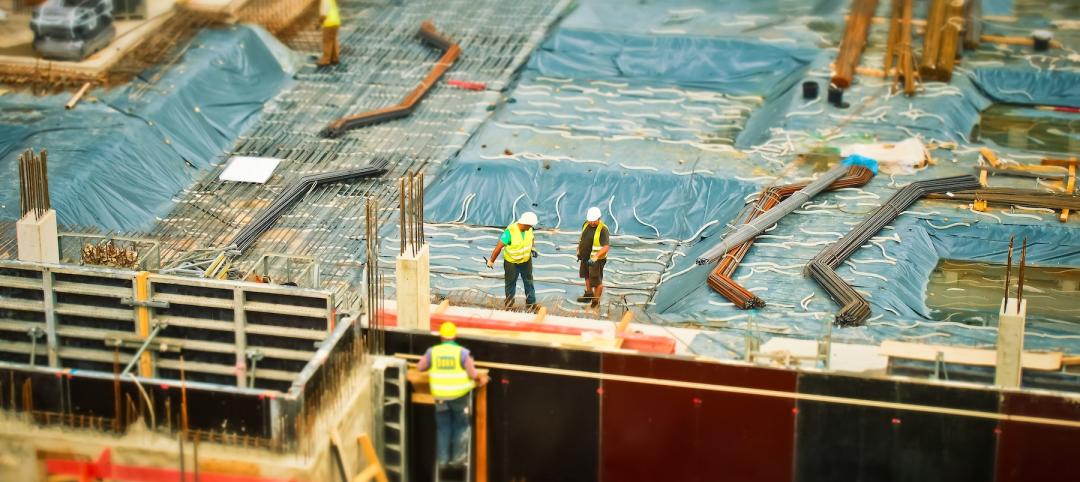As commercial construction perks up in numerous sectors, reconstruction is also on the rise. According to a report released in January by industry research firm IBISWorld, years of fairly lackluster demand for commercial property remodeling are ending, and reconstruction revenue is improving (http://bit.ly/1lnYTpa).
IBISWorld predicts about a 3% increase in commercial reconstruction revenues this year compared with 2013, followed by continued gains for the next five years. Among our BD+C Giants firms, reconstruction represents a growing percentage of revenues: a bit over 30% of the 2013 totals, compared with 27% for 2012.
IBISWorld credits much of the growth to improved corporate fortunes, leading to demand for workplace upgrades. Owner enthusiasm for sustainability-related remodeling is also driving continued improvement for the sector, according to the report. Renovations for education—where deferred improvements in infrastructure will eventually have to be addressed—and for healthcare and retail are likely growth areas.
IBISWorld’s analysis dovetails with the pattern of entrants to BD+C’s Reconstruction Awards program. Winners will be revealed next month, but office projects were unusually dominant this year, representing more than a third of submittals. A gamut of building types was involved, from adaptive reuses of warehouses for loft-like workplaces with Millennial appeal, to office-to-office reconstructions for private industry, nonprofits, and government agencies. Interestingly, a number of these projects involved midcentury behemoths instead of traditional grande dames.
GROWING APPRECIATION FOR MODERNIST STRUCTURES
TOP RECONSTRUCTION SECTOR ARCHITECTURE FIRMS
2013 Reconstruction Revenue ($)
1 Stantec $270,501,945
2 HDR 106,050,000
3 HOK 99,250,000
4 CannonDesign 93,000,000
5 Callison 80,992,574
6 Perkins+will 71,272,000
7 Leo A Daly 64,422,103
8 SmithGroupJJR 48,800,000
9 Hammel, Green and Abrahamson 47,634,302
10 NORR 47,086,734
SEE FULL LIST
TOP RECONSTRUCTION SECTOR ENGINEERING FIRMS
2013 Reconstruction Revenue ($)
1 Jacobs $1,842,130,000
2 URS Corp. 261,644,447
3 Wiss, Janney, Elstner Associates 68,083,200
4 CRB 68,000,000
5 Syska Hennessy Group 56,341,504
6 STV 55,451,000
7 Leidos 55,125,000
8 AKF Group 54,593,000
9 Dewberry 53,601,594
10 Thornton Tomasetti 53,009,856
SEE FULL LIST
TOP RECONSTRUCTION SECTOR CONSTRUCTION FIRMS
2013 Reconstruction Revenue ($)
1 Structure Tone $2,048,849,400
2 Turner Construction 2,024,000,000
3 Gilbane 1,861,820,000
4 Jacobs 1,605,895,000
5 DPR Construction 1,596,059,693
6 Whiting-Turner Contracting Co., The 1,221,682,434
7 PCL Construction 1,054,762,824
8 HITT Contracting 736,500,000
9 Consigli Construction 572,736,010
10 JE Dunn Construction 538,190,090
SEE FULL LIST
Buildings in the Beaux Arts, Romanesque, Georgian, and Art Deco styles have long been popular reconstruction candidates. Many such facilities are already landmarked—opening access to historic-preservation tax credits—and are affectionately viewed as essential to the local architectural and historical fabric. Facilities in these styles that are typical candidates for preservation through renovation or adaptive reuse include commercial and government offices, courthouses, hotels, apartments, academic buildings, train stations, and cultural buildings like libraries and theaters.
Giants 300 coverage of Data Centers is brought to you by Duro-Last http://duro-last.com.
The save-or-raze decision has sometimes been more difficult when the structure in question is of the Modernist/Brutalist variety—a scenario highlighted by the fate of Prentice Women’s Hospital in Chicago, a Bertrand Goldberg-designed structure that was iconic if not universally beloved. Demolition of the cloverleaf-shaped building commenced last fall after preservationists failed to persuade the city Landmarks Commission to protect it.
Elsewhere, however, stakeholders are choosing to leverage their midcentury assets through reconstruction. The U.S. General Services Administration has been a leader in using this strategy, and numerous examples popped up in the organization’s 2014 Design Awards. The redesigns are making the buildings more practical for current uses, and greener to boot.
Recent examples include the Edith Green-Wendell Wyatt Federal Building in Portland, Ore.; the Minton-Capehart Federal Building in Indianapolis; and the Dr. A.H. McCoy Federal Building in Jackson, Miss. The massive Thomas P. O’Neill Jr. Federal Building in Washington, D.C., won a BD+C Reconstruction Award last year for a radical rethinking that included both an exterior upgrade and a new atrium punched into the center.
Some private developers are on the bandwagon, too, and not just for office-to-office conversions. For instance, PCL Construction and Baker Barrios Architects recently led an adaptive reuse of the former headquarters of the Orlando Utilities Commission, which had been vacant for five years. Developer GDC Properties was able to have the Modernist building placed on the National Register of Historic Places, allowing use of historic tax credits for renovation. The result is the The Aloft Downtown Orlando Hotel.
ADVANCED FAÇADES GAIN POPULARITY
The Green-Wyatt Federal Building exemplifies another trend: the growing contribution of advanced façade technologies to reconstruction projects. Increasingly, façades that have been prone to air and water leakage are being replaced with attractive, energy-efficient assemblies.
In the case of Green-Wyatt, a modern glass curtain wall, accompanied by a rhythmic array of vertical-fin sunscreens, replaced a thick precast concrete facade. The redesign not only improved sustainability and freshened the appearance of the 18-story tower, but also increased rentable square footage because the new façade was much thinner than the one it replaced. The Building Team included CM/GC Howard S. Wright, a Balfour Beatty company; architects Cutler Anderson and SERA; and engineers Glumac, Interface Engineering, KPFF, and PAE Consulting Engineers.
Other patterns from our Reconstruction Awards submittals include the addition of PV and, sometimes, geothermal systems to existing facilities, as well as modern HVAC strategies like demand-controlled ventilation and variable refrigerant flow. Finding feasible, architecturally graceful ways to deploy new technologies in old buildings isn’t always easy; façade replacement and rooftop PV, in particular, can generate aesthetic debate. Nevertheless, with these technologies, reconstructions that would once have been deemed impractical can achieve a more favorable ROI and a lower carbon footprint.
LASER SCANNING REDUCES UNPLEASANT SURPRISES
Many Giants firms mention the powerful contribution of BIM to reconstruction, as with new projects. Increasingly, AEC pros are also making use of laser scanning technology to lessen the odds of unpleasant discoveries during construction. Whether buying their own equipment or outsourcing the work, firms are finding that the technology can yield big benefits, especially in situations where as-builts are suspect or nonexistent.
“There are always a large amount of unknowns in renovation, including hidden architectural features, structural components, and existing mechanical systems,” says Kyle Absher, Virtual Construction Manager at Absher Construction Co., Puyallup, Wash. “In the past, such elements often had a negative impact because there was not sufficient time to properly coordinate around them in advance. Laser scanning technology gives us the ability to create a 3D as-built using multiple scans from different phases of demolition. This information can be imported directly into our coordination software and accounted for when designing new systems, saving our company considerable time and money.”
Read BD+C's full 2014 Giants 300 Report
Related Stories
| Aug 17, 2022
New York to deploy 30,000 window-sized electric heat pumps in city-owned apartments
New York officials recently announced the state and the city will invest $70 million to roll out 30,000 window-sized electric heat pumps in city-owned apartments.
| Aug 17, 2022
IBM’s former office buildings in Boca Raton turn into a modern tech campus
Built in 1968, the Boca Raton Innovation Campus (BRiC), at 1.7 million square feet, is the largest office campus in Florida.
| Aug 16, 2022
DOE funds 18 projects developing tech to enable buildings to store carbon
The Department of Energy announced $39 million in awards for 18 projects that are developing technologies to transform buildings into net carbon storage structures.
| Aug 16, 2022
Multifamily holds strong – for now
All leading indicators show that the multifamily sector is shrugging off rising interest rates, inflationary pressures and other economic challenges, and will continue to be a torrid market for design and construction firms for at least the rest of 2022.
| Aug 16, 2022
Cedars-Sinai Urgent Care Clinic’s high design for urgent care
The new Cedars-Sinai Los Feliz Urgent Care Clinic in Los Angeles plays against type, offering a stylized design to what are typically mundane, utilitarian buildings.
| Aug 15, 2022
IF you build it, will they come? The problem of staff respite in healthcare facilities
Architects and designers have long argued for the value of respite spaces in healthcare facilities.
| Aug 15, 2022
Boston high-rise will be largest Passive House office building in the world
Winthrop Center, a new 691-foot tall, mixed-use tower in Boston was recently honored with the Passive House Trailblazer award.
Architects | Aug 12, 2022
Goettsch Partners names James Zheng, CEO, and Paul de Santis, Co-design Director
Global architecture firm Goettsch Partners (GP) announces that James Zheng, AIA, LEED AP, has been named CEO, and Paul De Santis, Assoc. AIA, LEED AP, joins James Goettsch, FAIA, as co-design directors for the practice. As the primary partners in the firm, the three have worked closely together for more than 17 years. Goettsch will also continue to serve as chairman while Zheng now assumes the full CEO title as well as president.
| Aug 12, 2022
Monthly Construction Input Prices Decreased 2% in July, Up 17% From a Year Ago, Says ABC
Construction input prices decreased 1.8% in July compared to the previous month, according to an Associated Builders and Contractors analysis of U.S. Bureau of Labor Statistics’ Producer Price Index data released today.
Hotel Facilities | Aug 12, 2022
Denver builds the nation’s first carbon-positive hotel
Touted as the nation’s first carbon-positive hotel, Populus recently broke ground in downtown Denver.


















